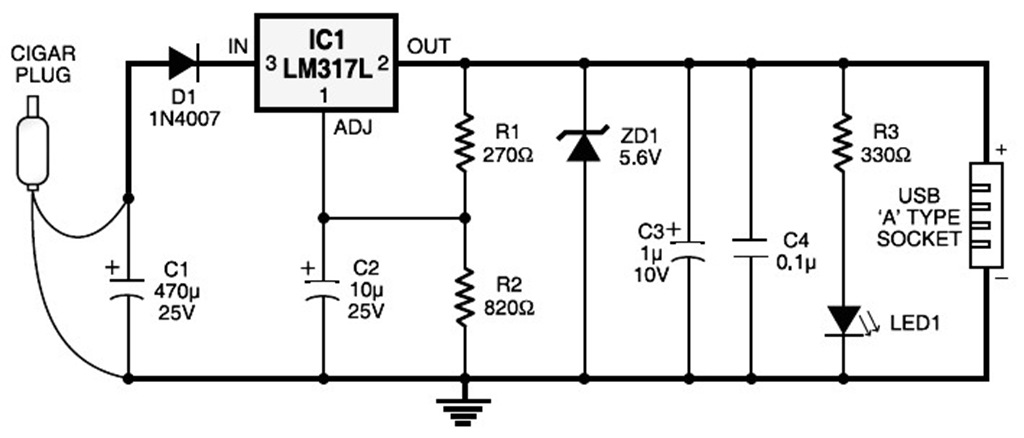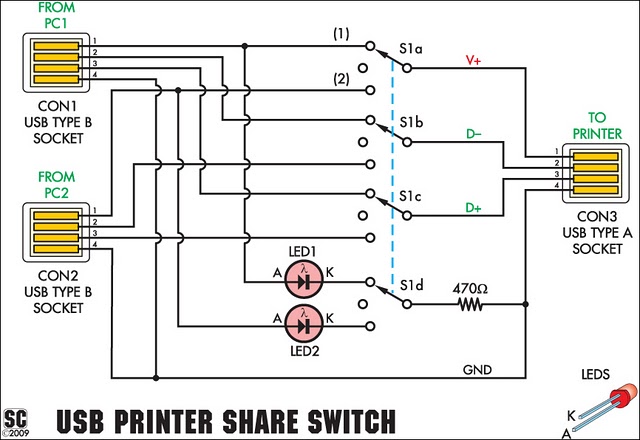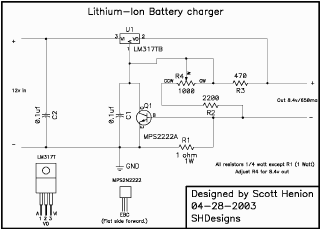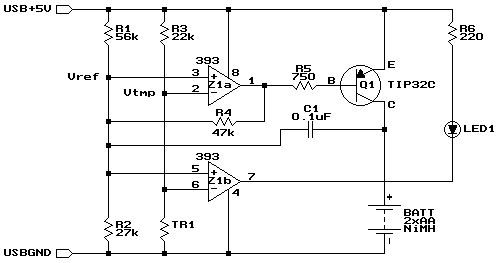
USB Battery Charger for AA NiMH and NiCd
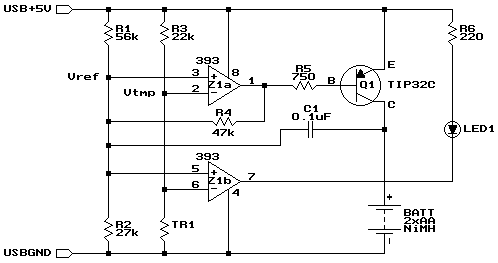
The charger in this project is designed to charge two AA NiMH or NiCd cells of any capacity (as long as they are the same) at approximately 470mA. It will charge 700mAh NiCds in about 1.5 hours, 1500mAh NiMHs in about 3.5 hours, and 2500mAh NiMHs in about 5.5 hours. The charger incorporates an automatic charge cut-off circuit based on cell temperature, and the cells can be left in the charger indefinitely after cut-off.
The described charger is a specialized device intended for charging two AA-sized nickel-metal hydride (NiMH) or nickel-cadmium (NiCd) batteries, ensuring that both cells are of identical capacity for optimal performance. The charging current is nominally set at 470mA, allowing for effective charging rates that vary based on the capacity of the cells being charged.
For example, the charger can fully charge 700mAh NiCd batteries in approximately 1.5 hours, while 1500mAh NiMH batteries will take around 3.5 hours. For larger 2500mAh NiMH batteries, the charging duration extends to about 5.5 hours. This flexibility in charging time accommodates a range of battery capacities, making the charger versatile for different applications.
A key feature of this charger is its automatic charge cut-off circuit, which is designed to monitor the temperature of the cells during the charging process. This safety mechanism prevents overcharging, a common issue that can lead to battery damage or reduced lifespan. Once the cells reach a predetermined temperature threshold, the charger will automatically terminate the charging process, ensuring the safety and longevity of the batteries.
Additionally, the design allows for the batteries to remain in the charger indefinitely after the cut-off has occurred. This is particularly advantageous for users who may want to keep their batteries charged and ready for use without the risk of overcharging. Overall, this charger represents a robust solution for maintaining the health and performance of AA NiMH and NiCd batteries.The charger in this project is designed to charge two AA NiMH or NiCd cells of any capacity (as long as they are the same) at about 470mA. It will charge 700mAh NiCds in about 1. 5 hours, 1500mAh NiMHs in about 3. 5 hours, and 2500mAh NiMHs in about 5. 5 hours. The charger incorporates an automatic charge cut-off circuit based on cell temperature, an d the cells can be left in the charger indefinitely after cut-off. 🔗 External reference
The described charger is a specialized device intended for charging two AA-sized nickel-metal hydride (NiMH) or nickel-cadmium (NiCd) batteries, ensuring that both cells are of identical capacity for optimal performance. The charging current is nominally set at 470mA, allowing for effective charging rates that vary based on the capacity of the cells being charged.
For example, the charger can fully charge 700mAh NiCd batteries in approximately 1.5 hours, while 1500mAh NiMH batteries will take around 3.5 hours. For larger 2500mAh NiMH batteries, the charging duration extends to about 5.5 hours. This flexibility in charging time accommodates a range of battery capacities, making the charger versatile for different applications.
A key feature of this charger is its automatic charge cut-off circuit, which is designed to monitor the temperature of the cells during the charging process. This safety mechanism prevents overcharging, a common issue that can lead to battery damage or reduced lifespan. Once the cells reach a predetermined temperature threshold, the charger will automatically terminate the charging process, ensuring the safety and longevity of the batteries.
Additionally, the design allows for the batteries to remain in the charger indefinitely after the cut-off has occurred. This is particularly advantageous for users who may want to keep their batteries charged and ready for use without the risk of overcharging. Overall, this charger represents a robust solution for maintaining the health and performance of AA NiMH and NiCd batteries.The charger in this project is designed to charge two AA NiMH or NiCd cells of any capacity (as long as they are the same) at about 470mA. It will charge 700mAh NiCds in about 1. 5 hours, 1500mAh NiMHs in about 3. 5 hours, and 2500mAh NiMHs in about 5. 5 hours. The charger incorporates an automatic charge cut-off circuit based on cell temperature, an d the cells can be left in the charger indefinitely after cut-off. 🔗 External reference
